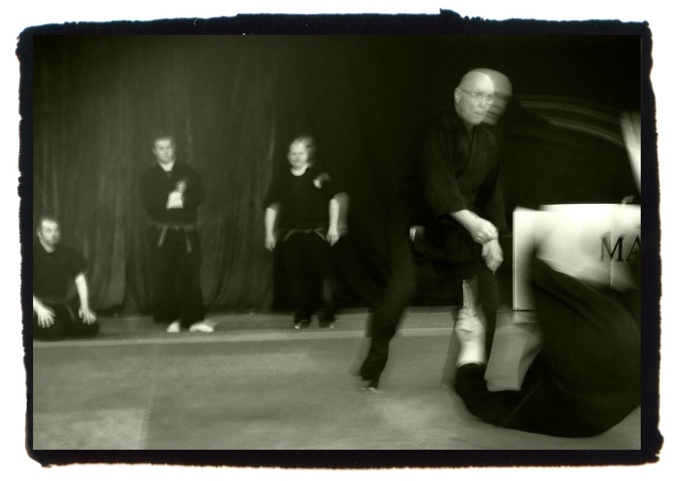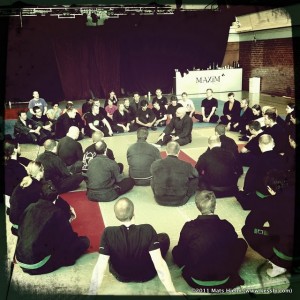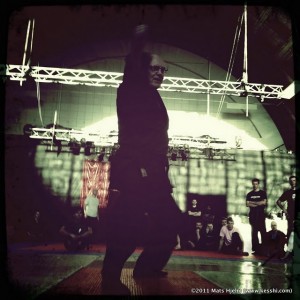From blogurl:tazziedevil.wordpress.com - Google Blog Search by Duncan Stewart
http://www.youtube.com/watch?v=rvdE0fHFvdc I am slowly working on a DVD set based on the Ten Chi Jin Ryaku no Maki. It is not instructional, but will give brief demonstrations ( my interpretation on the day ) of the waza within the Densho.… Read MoreYear: 2011
Ten Chi Ryaku no Maki 天地略之巻 Renshu
From blogurl:tazziedevil.wordpress.com - Google Blog Search by Duncan Stewart
http://www.youtube.com/watch?v=rvdE0fHFvdc. I am slowly working on a DVD set based on the Ten Chi Jin Ryaku no Maki. It is not instructional, but will give brief demonstrations ( my interpretation on the day ) of the waza within the ...… Read MoreHow to Win a Sword Fight
From Bujinkan Santa Monica by Bujinkan Santa Monica
 |
| Edo Wonderland Sword Fight, photo by -ratamahatta- |
One day Tesshu had a sword contest with a famous sword teacher, Asari Gimei. They fought for half a day and Tesshu was defeated. Tesshu became Asari's student and threw himself into Zen practice to try to understand the nature of his defeat.
As part of his search to understand what happened to him, he was given a koan to study by Tekisui Roshi'
"Crossed swords; neither permits retreat.This advanced koan shows both the problem presented by a fight and the solution. Tesshu sums up his problem here:
The sword-master, like a lotus in the fire,
Has a heaven-soaring spirit."
'[When] two swords cross, all thoughts turn towards striking the opponent.'
Tesshu explains that the desire to strike an opponent while avoiding being struck is deluded. Not because this is a physical impossibility but because 'Originally, the mind is thoughtless like a bright, unclouded mirror...When the mirror is completely clouded, nothing can be reflected.' He continues 'When confronting an opponent, thoughts of striking or being struck indicate ignorance and illusion.'
Tesshu struggled with the crossed swords koan for three years of training. One morning while sitting in Zazen, he had a breakthrough. He stood up and went to fight his teacher Asari in the dojo. Asari realized right away that Tesshu had pierced through the lesson and declined to fight. He formally named Tesshu his successor and never again picked up a sword. Tesshu became a famous sword instructor who taught the way of the sword as a spiritual path.
So what happens when you cross swords with an opponent? If you are not in Zanshin, you may experience two states of mind. One is a calculating, worrying state where the mind is constantly questioning: Can you hit your opponent? Can he hit you? How can you enter, is there an opening? Does he see an opening? Can you trick him? Can you try this move or attack? Does he know that strategy and will he use it? This state is limiting, creates fear and you are defeating yourself. The limiting thoughts are never ending...
The other state lets the whole universe run through you. You erase the self and there is no you, just boundless possibility, unafraid of being cut or cutting. Your opponents efforts are no problem whatsoever. Attacks dissipate like mist.
Hatsumi Sensei says that Tesshu found this enlightenment by hearing the song of the gods in his heart. Soke describes this gokui (essense):
"In the world of martial arts, one should not stick to strength or weakness, softness or hardness; rather one should transcend physicality and understand the void, 'ku,' regarding the body also as empty."Hatsumi Sensei goes on to explain how to use this gokui to win without drawing your sword,
"...prepare your body and show courage, the true gokui is the mind. Win without without drawing your sword. If you draw, do not cut down; bear patiently, and know that taking a life is a grave thing."
Det stora semmellägret i Gävle

Årets träningsläger sponsrat av Svenska Bujinkanförbundet hölls i Gävle den första helgen i mars 2011. Arrangemanget sköttes av Patrik Johansson och medlemmar från Bujinkan Gefle Dojo. Inbjuden instruktör var Sveneric Bogsäter som varit bosatt i Holland de senaste 20 åren.
 Det kom ungefär 75 träningssugna deltagare från hela Sverige för att träna och umgås. Årets Bujinkan-tema är Kihon-happō. Sveneric öppnade med att säga att temat för lägret är Kihon-happō med shūtohanpa principer. Vilket betyder att man gör tekniker halvfärdigt. På så sätt övar man på att överge sitt ego som vill hålla fast i det som man redan kan, och istället gör något fullständigt oväntat. Det är ett abstrakt tänkande och aningen svårbegripligt, vilket också är meningen.
Det kom ungefär 75 träningssugna deltagare från hela Sverige för att träna och umgås. Årets Bujinkan-tema är Kihon-happō. Sveneric öppnade med att säga att temat för lägret är Kihon-happō med shūtohanpa principer. Vilket betyder att man gör tekniker halvfärdigt. På så sätt övar man på att överge sitt ego som vill hålla fast i det som man redan kan, och istället gör något fullständigt oväntat. Det är ett abstrakt tänkande och aningen svårbegripligt, vilket också är meningen.
Kihon-happō består av åtta grundtekniker som vid en djupare analys blir åtta grundprinciper. Man kan ytterligare dela upp dom i två, ura och omote; förenklat, att fälla uke bakåt eller framåt.
Sveneric började med att låta någon frivillig att visa grundutförandet av omote-gyaku den första tekniken i toride-kihon-gohō i Kihon-happō. Sedan utgick Sveneric från denna teknik och visade detaljer och principer obeväpnat och med olika vapen.
Efter att ha sett oss (några?) ha alldeles för bråttom men ändå missa detaljer citerade Sveneric Wyatt Earp, “Fast is fine but accuracy is final. You must learn to be slow in a hurry.” Att vara snabb är okej, men ni måste lära er att skynda långsamt (fritt översatt). Med rätt tajmning och positionering behöver man inte vara särskilt snabb bara man gör rätt.
 En sak till vi fick kritik för med all rätt (jag håller fullständigt med) var att våra attacker, slag var ganska pinsamma. Jag har själv upplevt många gånger att man känner sig ganska säker på att inte bli träffad när man tränar här hemma, och man blir lite för avslappnad. När man som instruktör ber en Holländare, Tysk eller Kroat till exempel leverera en attack så är det en helt annan känsla. Flyttar man inte på sig så kommer slaget att träffa hårt. Träningen blir på en helt annan nivå. Så när Sveneric på ett vänligt sätt förklarade detta för oss hoppas jag att vi tar åt oss detta och tar attackerna på lite mer allvar.
En sak till vi fick kritik för med all rätt (jag håller fullständigt med) var att våra attacker, slag var ganska pinsamma. Jag har själv upplevt många gånger att man känner sig ganska säker på att inte bli träffad när man tränar här hemma, och man blir lite för avslappnad. När man som instruktör ber en Holländare, Tysk eller Kroat till exempel leverera en attack så är det en helt annan känsla. Flyttar man inte på sig så kommer slaget att träffa hårt. Träningen blir på en helt annan nivå. Så när Sveneric på ett vänligt sätt förklarade detta för oss hoppas jag att vi tar åt oss detta och tar attackerna på lite mer allvar.
Personligen tycker jag att man kanske bör attackera nybörjare lite mer försiktigt, men är det ett svartbälte man attackerar så bör slaget så länge det är rakt vara fullt ut för att båda två ska kunna träna mer realistiskt.
Ett stort tack till Patrik och grabbarna i Bujinkan Gefle Dojo, jag tänker på mannen (och hans flickvän) som bakade och bjöd alla på semlor. Det var en riktigt trevlig överraskning som blir svår att toppa för den som organiserar nästa års Bujinkan Sverige-träningsläger.
Grattis också till Jim och Hasse, det var verkligen på tiden!
För mer bilder från lägret se min hemsida.
/Mats – Kaigōzan Dōjō…
Read MoreRiga seminar in February 2011
From 8þ Kabutoshimen by admin
The past weekend I was invited by Juris from Bujinkan Kurokawa Dojo in Riga to teach a seminar on Sanshin no kata and Juttejutsu.
On Saturday I showed and explained the way I feel is the base for Sanshin no kata. First we did the traditional warm-up routine; doing the first technique five times on the right side, and then five times on the left side, and finally ten times alternately on right and left side. Then the same with all the other four techniques. Sanshin no kata consists of five simple techniques…

三心の型 SANSHIN NO KATA
地 CHI (earth)
水 SUI (water)
火 KA (fire)
風 FŪ (wind)
空 KŪ (void)
In the early 1980′s there was a “guy” that had only been training a couple of years and interpreted these techniques with Buddhism and created his own philosophy around these techniques. He wrote many books on the subject, and almost everyone copied his idea. It was a very nice idea, but it was not the Sanshin no kata that Hatsumi Soke taught as many people believed at the time (and unfortunately still believes). Do not think of the elements too much. Just simply look at them as a way of counting, nothing else.
Some people talk about three different ways of doing these techniques and they also have a name (shoshin, gogyo, goshin). I have never been taught this by Hatsumi Soke or any one else of the Japanese Shihan, and I have never seen the source for this. So I’m not teaching this, but I think this also is a good idea. I think it is important to always look at things from three perspectives. For example left, right and middle. The way I taught on the seminar was the following.

Solo training, try to get the form correct and understand all movements, angles, timing, distance, technique, kamae and everything else. I heard that even the Japanese Shihan who have been training for 30-40 years still do this every day. So there is no reason for you to think that you have already learned it. I to still discover many things when doing the forms.
With a partner you will understand the the solo training forms better. The forms you do in solo training will never bee exactly the same when done with a partner, you need to adjust according the way your partner attacks. We did the base (as I see it!) with five different blocks and five different strikes, then moved on to applications and more direct response from natural posture.
Using weapons will increase the understanding even more. If you use a weapon try to keep to the ideas we learn from the forms. But small adjustments are done according the characteristics of the weapons used.
http://www.youtube.com/watch?v=tN4XcGbDsm8
This 45 minute video from the seminar is available for instant download at BUDOSHOP.SE
十手術 JUTTEJUTSU
 The jutte or jitte (十手), literally meaning “ten-hand” (i.e., the weapon with the power of ten hands), is a specialized weapon. In Edo period Japan the jutte was a substitute for a badge and represented someone on official business and was carried by all levels of police officers including high ranking samurai police officials and low-rank samurai law enforcement officers (called okappiki or doshin). Other high ranking samurai officials carried a jutte as a badge of office, “aratame” or official inspectors including hotel, rice and grain inspectors carried a jutte.
The jutte or jitte (十手), literally meaning “ten-hand” (i.e., the weapon with the power of ten hands), is a specialized weapon. In Edo period Japan the jutte was a substitute for a badge and represented someone on official business and was carried by all levels of police officers including high ranking samurai police officials and low-rank samurai law enforcement officers (called okappiki or doshin). Other high ranking samurai officials carried a jutte as a badge of office, “aratame” or official inspectors including hotel, rice and grain inspectors carried a jutte.
On Sunday we did the six techniques from the old Hanbo, Tessen and Jutte book published by Hatsumi Soke in 1984 ca. It has six basic techniques, we did them all. In 2003 the Bujinkan theme was Kunai and Hatsumi Soke taught five of these techniques using a Kunai. The weapons are different so adjustments need to be made according the characteristics of these weapons.
We studied the following techniques with Jutte in mind (not Kunai), first the basic form and then variations and applications.
桐之一葉 KIRI NO HITOHA – falling paulowina leaf (arrival of autumn)
落花 RAKKA – falling blossoms
水鳥 MIZU-DORI – water bird / 五輪碎 GORIN KUDAKI – five rings crush
雷閃 RAI-SEN – flash of lightning
竜下 TATSUGE – inferior dragon
廻捕 MAWARIDORI – revolve and capture
The training both days seemed to be successful and everyone seemed happy about it. I sure had a good time both in the dojo and outside before, between and after the trainings. The first time I was in Latvia in 2002? I asked about traditional masks but I didn’t know so much about them that they understood what I meant. So after the training Juris surprised me with a mask I asked about nearly ten years ago.
The arrival of masked visitors
 This practise is variously referred to as budēļi, čigāni “gypsies, going gypsying”, kaladnieki, ķekatas, maski “masks, going masking”, nabagi “the poor ones”, etc. Although this practise could occur at any time of the winter (between Mārtiņi and Meteņi ), it was particularly common on Christmas eve. It is strongly reminiscent of the tradition of mummers and mummering in Great Britain and Newfoundland.
This practise is variously referred to as budēļi, čigāni “gypsies, going gypsying”, kaladnieki, ķekatas, maski “masks, going masking”, nabagi “the poor ones”, etc. Although this practise could occur at any time of the winter (between Mārtiņi and Meteņi ), it was particularly common on Christmas eve. It is strongly reminiscent of the tradition of mummers and mummering in Great Britain and Newfoundland.
Latvian “mummers” might dress up as animals (bears, horses, cranes) or as Death. They would go from house to house and were warmly greeted, as they were assumed to drive away evil spirits. They would arrive in groups in front of the house, and sing songs and dance. Then they would be invited in and fed with bacon buns (pīrāgi), butter, sausages, and given ale to drink. They made a special effort to disguise their voices and mannerisms, so that no one would be able to guess who each one was, but if a mummer was correctly identified, he or she would have to “unveil”, i.e. remove the cloth which was covering their face.
It is still common for children to be required to recite an appropriate verse before receipt of their presents (there are many).
Vai, lielie ziemas svētki,
Puiši trekni, zirgi vāji;
Puišiem alus, brandavīns
Zirgiem tukšas redelītes.
Oh my, Christmas time
The lads are fat, the horses lean;
The lads get beer and whiskey
But the hay racks are empty.
I’m happy about the whole seminar, and especially happy that people also came from the neighboring countries Estonia and Lithuania. I was asked to come back after summer, maybe in August. I’m already looking forward to it.
Thank you Juris and everyone who attended and made the seminar possible.
Happy training!
Click here for more pictures from the seminar.
The post Riga seminar in February 2011 appeared first on 8þ Kabutoshimen.…
Read More
